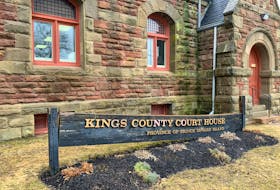ANNAPOLIS ROYAL, NS - Four municipal partners are hoping their joint entry into a federal Smart Cities Challenge will land them the cash to study the possibility of building a flood mitigation system and renewable energy source at the Digby Gut.
“It’s basically proposing a gate that would close during storms to redirect the significant flow of water,” said Annapolis Royal Mayor Bill MacDonald, adding that the necessary superstructure would also generate tidal electricity. “So a renewable resource. The gates would remain open to vessel traffic, to marine traffic, and marine life until there was a reason to close it.”
Annapolis Royal is partnering with the Municipality of the County of Annapolis, the Town of Digby, and the Municipality of the District of Digby as they compete in the challenge that could mean a $250,000 prize to fund an engineering study to see if the sea gate proposal is workable.
The Digby Gut is a 4.5-kilometre opening from the Bay of Fundy to the Annapolis Basin measuring from 800 metres at its narrowest to 1.6 kilometres at its widest. Directly south through the Gut is the town of Digby and Smiths Cove. To the northeast up the Annapolis Basin are numerous communities including Port Royal, Cornwallis, Granville Ferry and Annapolis Royal.
The Smart Cities Challenge encourages communities to adopt a smart cities approach to improve the lives of their residents through innovation, data, and connected technology. The regional partners have entered in the $10-million prize category that is for communities under 500,000 residents.
Sea Level Rise
The Smart Cities Challenge entry comes as Annapolis Royal’s town council and residents in the area are taking action against the threat of rising sea levels. MacDonald said the four regional partners have that threat in common in the communities all along the basin.
“All will ultimately be affected by rising sea levels – the Town of Annapolis Royal and the Town of Digby probably more than any because our town sites, our buildings, our infrastructure are at sea level … so the rising sea level seemed an issue for all of us to come together on,” said MacDonald. “It’s the opportunity to compete with other communities in Canada, and regions of Canada, come together to conceive of, be imaginative about how to solve the problem that the world recognizes is inevitable. And we’re seeing the evidence and the consequences of it already.”
He said there was no dispute among the four regional partners to come together on the issue and on the project.
“We recognize that it’s an ambitious proposal but we also think it’s attainable,” he said. “In its simplest terms, the proposal is going to the source of the problem, so we’re hoping where the water comes in that there’s some way that we can mitigate the impact on all of our regions, all of our land.”
Precedent
MacDonald said precedent for such a project exists throughout the world and gave examples of the Thames Barrier in London that’s been in place since 1984, and the Maeslantkering – a storm surge barrier – in Rotterdam, The Netherlands that was built in the 1990s. Both barriers protect against the North Sea.
“Very much like the significant body of water The Fundy, the North Sea is a remarkably powerful body of water with huge storms,” said MacDonald. “In Holland they’ve suffered the consequences of that.”
At home, he said we’re dealing with a body of water that has the highest tides in the world.
“Now, introduce into that element an increase in sea levels so you compound the impact of that,” he said. “Right now the storm surges that we see in the wintertime are rising so we can anticipate this will be much more in the future. The question then becomes for us ‘how do you deal with that?’ We are looking at mitigating it all along our waterfront here in the town of Annapolis Royal.”
But, he said the regional partners are coming together looking at the Digby Gut as the place to mitigate at the source.
Imagination
Because of hydrodynamics and the velocity of water coming through the Digby Gut from the Bay of Fundy, MacDonald expects building a gate isn’t going to be a simple feat.
“The engineering of any kind of superstructure there is going to require imagination,” he said. “I’m excited to see our proposal move forward to the point where we get approval to bring in the experts to look at this area, to examine how in fact we can use the Gut to mitigate the storms, but also to actually generate power.”
Environmental assessment would be part of any study, MacDonald said. He said tidal power generation in the superstructure would have to include new technology that is sensitive to marine life.
“I really can’t talk much more about that other than to say that some new advances in turbine models have reached out to the town and there have been discussions about proposals about how their technologies might be integrated into the superstructure,” he said. “Their design is such that the impact on marine life would almost be nominal at best.”
He said if the partners are successful and receive a monetary award from the Smart Cities Challenge, he’s hoping for the $250,000 to bring the experts in to study the proposition.
“In the application we’re talking in very broad strokes and trying to reflect the possibilities of this structure using one’s imagination without the benefit … of any significant engineering background but understanding the precedent has been set,” he said.
Dr. Webster
Dr. Tim Webster from Nova Scotia Community College’s Applied Geomatics Research Group recently gave a public presentation in Town of Annapolis Royal. MacDonald said Webster was going through a slide show that included some of the precedents and approaches to dealing with rising sea levels.
“In fact there were superstructures and images of gates for the audience to sort of see that (sea gates),” MacDonald said. “So there was great excitement in the room when I announced the regional partners had come together to look at that as a possibility here.”
Annapolis Royal CAO Greg Barr and Mayor MacDonald recently met with Dr. Webster and some of his students at Nova Scotia Community College in Middleton.
“We were very impressed with the modeling programs being developed,” said MacDonald. “He’s offered his services and input as we sort of move forward on this. He’s a leading expert. To have somebody of his caliber in the area who is interested in assisting the town is just remarkable. It’s wonderful.”
The four regional partners have heard back from Infrastructure Canada that their application has been accepted. “So we’ve crossed the first hurdle – we met the parameters of the application. So now we’ll just wait. If they need more information perhaps they’ll reach out to us. We’ll wait to see.”








